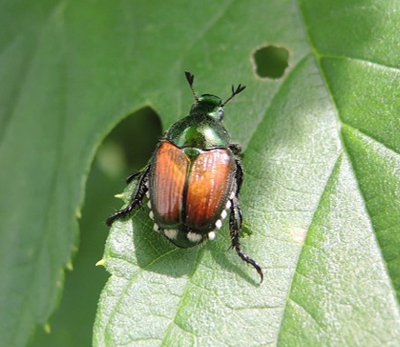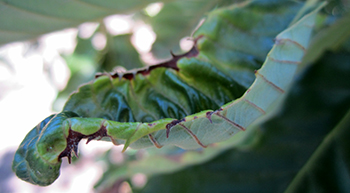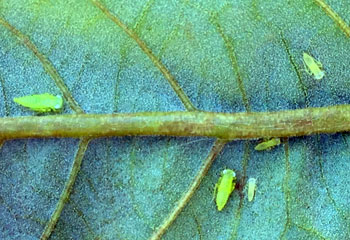Michigan chestnut scouting report for July 10, 2015
Japanese beetles are emerging in southern and central Michigan and potato leafhopper populations are substantial.

Chestnut tree development is variable this season due to winter injury and frost damage. Pollen shed is underway in some orchards, but many terminal flower buds were damaged and it is unclear if flowers developing on lateral buds will open while pollen is available.
Rose chafer populations are down dramatically, and just in time for Japanese beetles to begin emerging around the state. Japanese beetle adults are considered a generalist pest and affect many crops found on or near grassy areas, particularly irrigated turf. Japanese beetle grubs feed on grass roots in early spring and again in fall and can cause significant damage to turf. Larvae prefer moist soil conditions and do not survive prolonged periods of drought. Adult Japanese beetles emerge in early July and feed on hundreds of different plant species. Adult beetles feed on the top surface of leaves, skeletonizing the tissue. If populations are high, they can remove all of the green leaf material from the plants.
There are no established treatment thresholds or data on how much Japanese beetle damage a healthy chestnut tree can sustain, but growers should consider that well-established and vigorous orchards will likely not require 100 percent protection. Younger orchards with limited leaf area will need to be managed more aggressively. Managing Japanese beetles can be a frustrating endeavor as they often re-infest from surrounding areas, especially during peak adult emergence in July. This re-infestation is often misinterpreted as an insecticide failure, but efficacy trials have shown that a number of insecticides remain effective treatment options.
Japanese beetles adults are a substantial insect and measure 0.375-0.5 inches long. The thorax is green and wing covers are copper. There are five tufts of white hairs on both sides of the abdomen and a pair of tufts on the end of the abdomen that can help distinguish Japanese beetles from other look-alike species. The legs are black.

Adult Japanese beetle.
Visual observation of adults or feeding damage is an effective scouting technique. Growers should scout along a transect through orchards at least weekly until detection, paying special attention to the tops of trees. Because of their aggregating behavior, they tend to be found in larger groups and are typically relatively easy to spot. Pheromone and floral baited traps are available and potentially can help indicate the arrival of adults and help estimate the potential pest pressure, but are not considered effective for trapping out Japanese beetles. Growers considering traps should remember they may attract Japanese beetle adults from surrounding areas and contribute to damage. For more information on insecticides available for the treatment of Japanese beetles, refer to “Pesticides registered for edible chestnuts, 2015” by Michigan State University Extension and always read the label.

Japanese beetle damage on chestnut leaf.
Potato leafhopper numbers remain substantial with damage visible at many locations. Like many plants, chestnuts are sensitive to the saliva of potato leafhoppers, which is injected by the insect while feeding. Damage to leaf tissue can cause reduced photosynthesis which can impact production and quality, and damage the tree. Most injury occurs on new tissue on shoot terminals with potato leafhoppers feeding near the edges of leaves using piercing-sucking mouthparts. Symptoms of feeding appear as whitish dots arranged in triangular shapes near the edges. Heavily damaged leaves are cupped with necrotic and chlorotic edges and eventually abscise from the tree. Severely infested shoots produce small, bunched leaves with reduced photosynthetic capacity.

Potato leafhopper feeding damage to chestnut, causing leaf cupping and necrotic margins.
Adult leafhoppers are pale to bright green and about 0.125 inches long. Adults are easily noticeable, jumping, flying or running when agitated. Nymphs or immature leafhoppers are pale green and have no wings, but are very similar in form to the adults. Potato leafhoppers move in all directions when disturbed, unlike some leafhoppers which have a distinct pattern of movement. Potato leafhoppers can’t survive Michigan’s winter and survive in the Gulf States until adults migrate north in the spring on storm systems.

Potato leafhopper adults and nymphs at various stages of development on the underside of chestnut leaves.
Scouting should be performed weekly as soon as leaf tissue is present to ensure early detection and prevent injury. More frequent spot-checks should be done following rain storms which carry the first populations north. For every acre of orchard, select five trees to examine and inspect leaves on three shoots per tree (a total of 15 shoots per acre). The easiest way to observe potato leafhoppers is by flipping shoots or leaves over and looking for adults and nymphs on the underside of leaves. Pay special attention to succulent new leaves on terminals of branches. For more information on insecticides available for the treatment of potato leafhopper, refer to “Pesticides registered for edible chestnuts, 2015.”
In case you missed the article, Asian chestnut gall wasp has been found in Michigan. Please carefully check your orchards for this important invasive pest now. Growers should also be on the lookout for European red mites as populations may build in the coming weeks.



 Print
Print Email
Email



